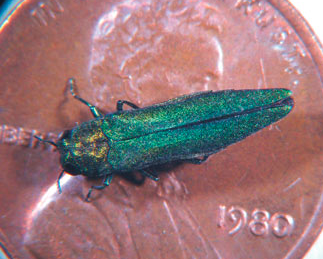
For the first time, the Emerald Ash Borer (EAB) has been identified in trees in Southbury, CT.
The Emerald Ash Borer was first discovered in America in June 2002 in Michigan. It is believed to have been brought to America unintentionally in ash wood which was used to stabilize crates during shipping. The invasive insect was first spotted in Connecticut in 2012 in Naugatuck and Prospect and last year was identified in nearby Sherman, CT.
In Connecticut, a quarantine was previously established that regulates the movement of ash logs, ash materials, ash nursery stock, and hardwood firewood from within New Haven County to any area outside of that county. The New Haven County quarantine mirrors a federal quarantine also imposed on New Haven County. The Fairfield County detection in Sherman, CT resulted in the expansion of the state and federal quarantines in Connecticut.In addition to the established quarantine, regulations are in effect regulating the movement of firewood from out of state into Connecticut or within Connecticut, including the requirement of a permit to bring out-of-state firewood into Connecticut. These regulations were put in place to ensure that EAB and other invasive insects are not carried into Connecticut, or spread throughout New England, through the movement of firewood.
Whats' so bad about this Bug?
Larva feeding in the tissue between the bark and sapwood disrupts the transport of nutrients and water in the tree, eventually causing branches and the entire tree to die. The most significant damage to a tree by the emerald ash borer takes place when the insect is in its larval stage. In an infestation, bore holes and serpentine feeding galleries of the larvae essentially disrupt the flow of nutrients as they rise up the trunk from the roots to the crown via the phloem (the tree's vascular structures) just under the bark. This eventually results in the death of the tree. This can take place over a number of years, and the first noticeable sign is usually some die back in the crown of the tree. The tree will usually be dead by the following year or soon after. In areas where the insect is invasive and has no natural predators, it can and usually does have a devastating effect on the local ash tree population. (source: Wikipedia)
